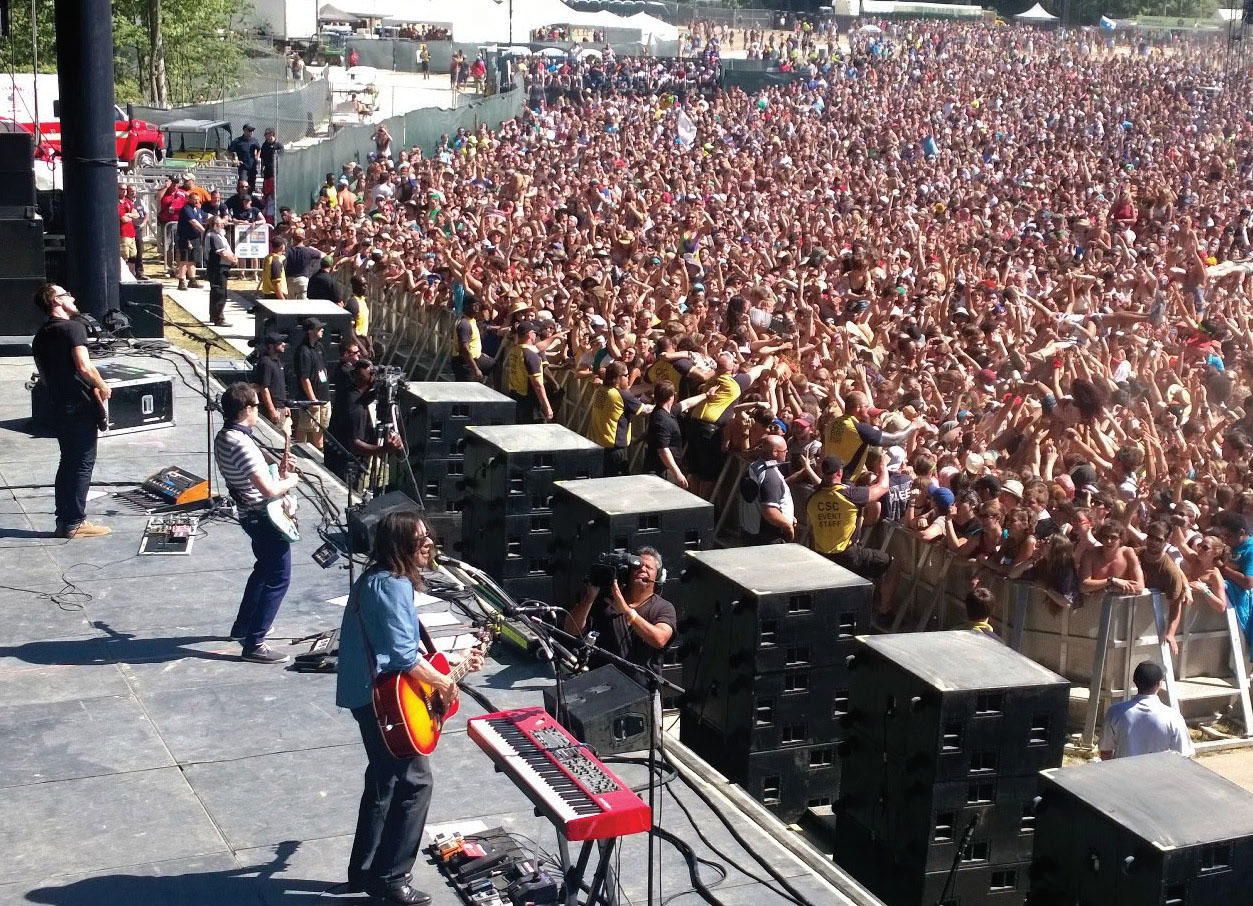Subwoofer cancellation is not an unusual occurence, particularly for open-air applications. Performance is not good in some audience areas. Sometimes a specific model of sub gets the blame. The underlining problem is that of the interaction between subwoofer stacks located on each side of the stage.
So let’s shed some light on this problem and remove part of that “veil of mystery” that surrounds it, due mostly to the lack of published material.
What’s Going On?
Whenever we have loudspeakers located on both sides of a stage, there is always interference between them, assuming, that is, that they carry the same signal.
As seen in Figure 1, when the distance to both sides is the same, sound from both sides arrives at the same time. As we are closer to one side and farther from the other, sound from one of the sides arrives before the other. This time arrival difference produces comb filtering effects.
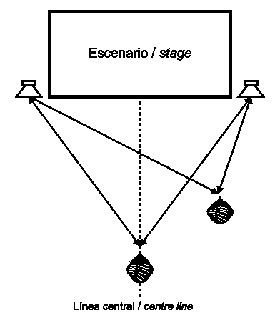
Comb Filtering
When two signals, one of which is delayed in time with respect to the other, are added, we get the well-known comb filter effect. This is due to destructive interference.
Figure 2 shows the resulting frequency response of summing two signals with a time difference of 7 milliseconds, which is equivalent to 2.5 meters (8 feet). The spacing between the troughs (“combs”) increases as frequency goes down.
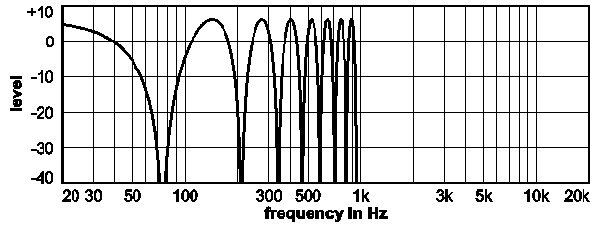
Absolute cancellation occurs at frequencies where the time arrival difference results in 180 degrees of phase difference between the two signals, so these frequencies get wiped out.
As any frequency response anomaly, the audibility of comb filtering is a function of the width of the troughs. These are wider for the lowest frequencies, which makes comb filtering more audible for those frequencies.
Comb filtering cannot be corrected by using equalization, since there is absolute cancellation at the bottom of the troughs. Only if one of the two signals is greater in level than the other will the effect be diminished and the combs reduced in depth.
The Problem
If the time arrival difference were constant, we would simply compensate by delaying one side and go home happy. However, each listening position (except the center line) gets sound arriving from each side with a different delay between them, which means that delaying one subwoofer stack would just shift the sweet spot elsewhere.
Also, the combs are in different frequencies at different positions, which means that the frequency response is widely different through out the audience area.
The problem is not as bad for the mid and high frequencies. First, because the troughs are narrower, and hence less audible. Second, because the zones created are smaller. With bass frequencies, one can literally walk the different cancellation areas, whereas the high frequency zones may be so small that the left and right ears do not share zones, so that the effects of cancellation are not as destructive.
Also, sources are more directive as frequency goes up. This means that when the audience is closer to one of the sides, they tend to be to some extent inside the main coverage beam of one side of the system and outside of the other, so comb filtering effects are reduced.
But with subwoofers, the situation is a nightmare. Combs are wide and very audible. Kick just seems to disappear in some places. And, since the wavelengths involved are so large (e.g., ~5 meters or 16 feet at 70 Hz), zones are enormous.
Since subwoofers are omni-directional below, say, 150 Hz, the whole audience area is within coverage of both sides of subwoofers. ALL types of subwoofers suffer from interference effects no matter what the type (direct radiating, folded horn) or brand.
The result is the “power alley”, which describes the fact that only a narrow center line of a left and right subwoofer system gets interference-free bass.
Modeling (getting the finger…)
We will now use electro-acoustic modeling to reveal the phenomenon. These predicted coverage maps are very close to what happens in real life in open air applications. Closed rooms add a reverberant field, which tends to smooth coverage out, and room modes, which create additional zones of their own.
We have placed 3 x 2 stacks of double 18-inch bins both sides of an 8-meter (27 feet) wide stage. An audience area of 60 meters (200 feet) wide and 52 meters (175 feet) long is used.
The first coverage map (Figure 3) corresponds to 100 Hz. We have switched on just one side of subwoofers just to see what happen when all our bass emanates from a single stack. Sound pressure level expands smoothly in a way that is close to the distance-squared law. So far so good.

Problems knock on our door when both sides are on (Figure 4). Also at 100 Hz, we can now see some kind of alien hand with five fingers. These are maximum pressure lobes, where the phase difference between the left and the right sides is small.
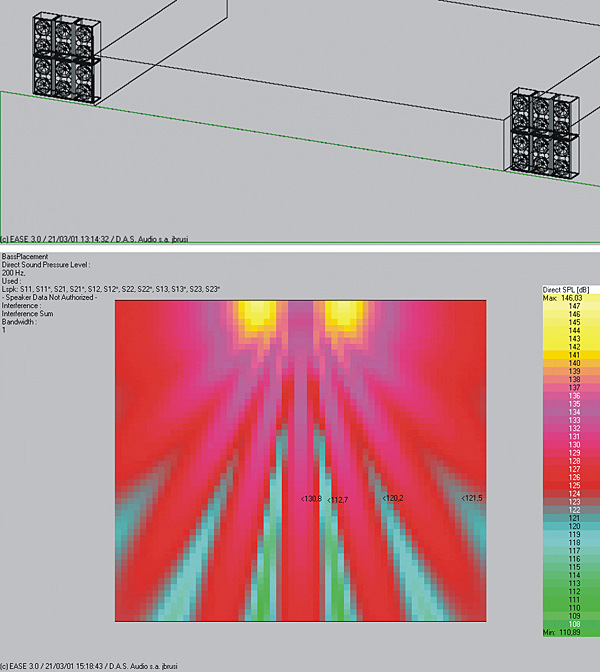
The areas between the lobes represent cancellation. Level readings show levels down 20 dB from the lobes. That means our 100 Hz pretty much walks out on us.
OK, so at least some folks are enjoying good bass, right? Wrong. Areas where the 100 Hz are in phase will have other frequencies out of phase, so there aren’t any “good” areas (except for the centre line).
Naturally, some frequencies are more important than others when dealing with bass guitar or bass drum, so our problems will be more evident in some areas than others.
Figure 5 shows what is taking place in the location seen on Figure 4, which is 4 meters (13 feet) off to the side. On the top part we see that the closest group of subwoofers arrives about 2.5 milliseconds (ms) before the other. On the bottom part, we see the resulting frequency response, where the first trough occurs at about 100 Hz.
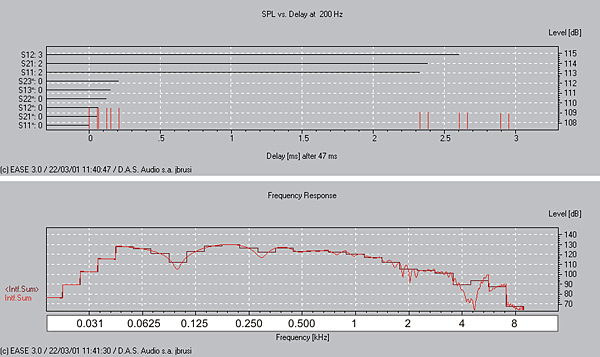
The following illustrations show modeling for 80, 63 and 50 Hz, respectively, in Figures 6-8. Note how the number and location of the lobes varies with frequency.

So, where is that alley?
For each frequency we have a map with fingers. If we sum several frequencies and plot them on a single map, the alley emerges, since it represents the only locations where bass sums coherently at all frequencies.
The width of the alley depends on the spacing of the subwoofers: as the two sides of subwoofers increase in spacing between each other, the alleyway will narrow.
Figure 10 shows the alley for two single subwoofer boxes spaced 14 meters (47 feet). It is not as obvious graphically as it is audibly, but it can still be distinguished as an approximately 4-meter (13-foot) band with more intense color.

Conclusion
The only real way to avoid the powerhouse alley is to place all subwoofers in a single location. With smaller scale applications, placing all the subwoofers in the center is normally not a possibility, but the larger shows may benefit from flying subwoofers in the center.
It is important, however, to understand what is happening, so as not to blame the speakers. And being aware of the zones that get created before taking mixing decisions.
For instance, if the front of house console is located in the center, we could chose a mix that is somewhat bass-heavy when listened to along the center line. Off to the sides, destructive interference will kick in and establish some frequency balance between the low frequencies and the rest of the system.

